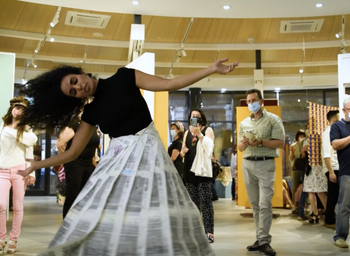Permitted (Yevamot)
In the heart of Jerusalem, on Haneviim Street, a sort of border between ultra-Orthodox and secular neighborhoods, the Jerusalem choreographer Efrat Nehama presents a disorienting dance performance. Efrat dances in a skirt she made from Gemara pages. Not just any Gemara. The skirt is made of sheets of paper on which the Yevamot tractate is printed.
The idea was born from the printed sheets I found in a Geniza bin in Jerusalem, near a printing house. I looked at the sheets and they fascinated me. I collected some of them to take home and they rested in my living room for several days. The presence of the controversial texts, in my eyes, was very strong. Yevamot is a complex Talmudic text that determines the fate of women, while it mostly deals with the law of childless widows and adultery.
The written laws deal with “women’s affairs”, but a woman’s voice is absent from them. It is men who are the authors of the text. The texts shocked me. I wanted to relieve the pain of these anonymous women referred to in the tractate as “rivals,” and to allow them a kind of mystical release. As soon as I finished gluing the pages to the skirt, it was clear to me that I wanted to dance in it. I felt that the experience of dancing would allow me to disintergrate the ties between the words and set free all those imprisoned and limited – chained women. During the performance, I invited the participants to draw on the skirt. By inviting this action, I allowed a redrawing of sketches that aspire to freedom and female personal expression, as opposed to the sketches found in the tractate. In the soundtrack played in the background, controversial parts of the tractate are read as poetry, accompanied by melancholy vocal music.
In my eyes, dance is a spiritual matter that has the power to connect body and soul, and to dismantle what exists in order to make something new out of it. I hope that the dance was indeed able to sustain a new spirit in the world, and to divest the text of its power. After I danced with the skirt, it was placed in the Azrieli Gallery, at Hadassah College, for several months, with a screen projecting the dance next to it. It was controversial and elicited many reactions. There were those who saw this as a violation of Judaism and of the holy texts.
It is important for me to point out that the work was not created in order to defy or to be provocative. The action was done in good faith, out of a true feeling that there is holiness in the body of the dancing woman. The skirt does not try to take a Jewish symbol and demean it. On the contrary, it tries to lift it up as a miracle and to ask a real question about it, to open it up and lift it beyond the dimension of time and space, to give it flight and a new spirit through the unity of the dancing body. In my eyes, the importance of ancient Jewish texts is that we discuss them anew, experience them in our bodies and in our flesh, and dance them, thus connecting body and soul, old and new, to a contemporary and living reality.
Credits:
Still photography: Natasha Shehans
Video: Shaul Weinstein
Curator: Tali Kayam
Performed and exhibited as part of the exhibition ‘Fabric Stories,’ at the Azrieli Gallery in Jerusalem , June 2021
Efrat Nehama is a choreographer, poet and performing artist who lives and works in Jerusalem.
Reflections
Reflect
Do you think dance has the power to dismantle the baggage of problematic meanings found in ancient text?
React
In your opinion, does this work detract from the sanctity of the text, or does it enhance it?
Want more?
Get curated JewishArts.org content in your inbox



